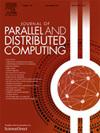Teaching parallel and distributed computing in a single undergraduate-level course
IF 3.4
3区 计算机科学
Q1 COMPUTER SCIENCE, THEORY & METHODS
引用次数: 0
Abstract
As the application of parallel distributed computing (PDC) becomes ever more pervasive, it is increasingly important that undergraduate CS curricula expose students to a wide range of PDC topics in order to prepare them for the workforce. We present the curricular design and learning goals of an upper-level undergraduate course that covers a wide breadth of topics in parallel and distributed computing, while also providing students with depth of experience and development of problem solving, programming, and analysis skills. We discuss lessons learned from our experiences teaching this course over 15 years, and we discuss changes and improvements we have made in its offerings, as well as choices and trade-offs we made to achieve a balance between breadth and depth of coverage across these two huge fields. Evaluations from students support that our approach works well meeting the goals of exposing students to a broad range of PDC topics, building important PDC thinking and programming skills, and meeting other pedagogical goals of an advanced upper-level undergraduate CS course. Although initially designed as a single course due to constraints that are common to smaller schools, our experiences with this course lead us to conclude that it is a good approach for an advanced undergraduate course on PDC at any institution.
在单一的本科水平课程中教授并行和分布式计算
随着并行分布式计算(PDC)的应用变得越来越普遍,本科CS课程让学生接触到广泛的PDC主题,以便为他们的工作做好准备,这一点变得越来越重要。我们提出了一个高级本科课程的课程设计和学习目标,该课程涵盖了并行和分布式计算的广泛主题,同时也为学生提供了解决问题、编程和分析技能的深度经验和发展。我们讨论了15年来我们教授这门课程的经验教训,我们讨论了我们在课程中所做的改变和改进,以及我们为实现这两个巨大领域的广度和深度之间的平衡而做出的选择和权衡。学生的评价支持我们的方法很好地满足了让学生接触广泛的PDC主题,培养重要的PDC思维和编程技能,以及满足高级本科CS课程的其他教学目标的目标。虽然由于小型学校的限制,最初设计为单一课程,但我们对这门课程的经验使我们得出结论,对于任何机构的PDC高级本科课程来说,这都是一个很好的方法。
本文章由计算机程序翻译,如有差异,请以英文原文为准。
求助全文
约1分钟内获得全文
求助全文
来源期刊

Journal of Parallel and Distributed Computing
工程技术-计算机:理论方法
CiteScore
10.30
自引率
2.60%
发文量
172
审稿时长
12 months
期刊介绍:
This international journal is directed to researchers, engineers, educators, managers, programmers, and users of computers who have particular interests in parallel processing and/or distributed computing.
The Journal of Parallel and Distributed Computing publishes original research papers and timely review articles on the theory, design, evaluation, and use of parallel and/or distributed computing systems. The journal also features special issues on these topics; again covering the full range from the design to the use of our targeted systems.
 求助内容:
求助内容: 应助结果提醒方式:
应助结果提醒方式:


